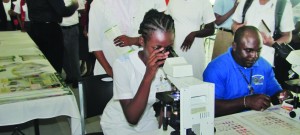Participants from different segments of society were told last Thursday that there was need for wider integration of stakeholders to deal with malaria, since the disease is still a public health threat.

This was underscored by Health Minister, Dr Bheri Ramsaran at the first malaria conference held under the theme “Malaria and the National Agenda – Recalibrating our Response: emerging challenges, networking and new initiatives”. The conference was attended by medical professionals, toshaos, regional health officers, and students from the Cyril Potter College of Education (CPCE), Kuru Kuru Training Centre and the Hinterland Scholarship Programme, among others.
According to a Government Information Agency (GINA) release, Minister Ramsaran noted that the government of Guyana through the Health Ministry has achieved significant gains in the fight against malaria. These efforts, he noted, are supported by international agencies, including the Pan American Health Organisation (PAHO) and Global Fund.
He expressed appreciation to PAHO, Guyana’s longest serving technical partner, and Global Fund for their support in tackling malaria and other diseases like HIV/ AIDS. The Health Ministry remains the major player in the national malaria prevention and control services.
“The gains in the fight against malaria are noteworthy; however, the Ministry of Health continues to be vigilant… recent reviews by the ministry indicate that there is continued cause for concern, that our concerns are well-grounded, both in analysing the international situation and locally,” the minister emphasised.
Recalibration
He explained that the results of the review indicate that returns on the collective efforts of the Health Ministry and its international partners are not as encouraging as they should be, hence it was time to pause and take stock. Consequently, the ministry is actively reviewing its work with the intent of recalibrating its response to the emerging challenges and dynamics which have outgrown previous efforts.
Minister Ramsaran pointed out that the ministry had taken stock of the review done by PAHO entitled the “Guyana Vector Control Needs Assessment Report”, concurring with several of the findings, including the opportunities for addressing vector control challenges.
In addressing the issue of a higher level of integration, he pointed to the distribution of Long Lasting Insecticide Nets (LLINs) through the Regional Democratic Councils of Regions Seven and Eight, the Public Works Ministry, Guyana Forestry Commission, Guyana Geology and Mines Commission, Guyana Forest Producers Association, and the Guyana Gold and Diamond Miners’ Association.
Thus far, more than 37,000 nets have been handed over to the organisations for distribution. This initiative is part of the larger vision which will see 50,000 nets being distributed in 2013.
Chief Medical Officer, Dr Shamdeo Persaud noted that Guyana was one of the countries in South America that had been affected by malaria for a number of decades; however, in the early 1950s, Guyana was able to reduce malaria to such an extent that the possibility of elimination was on the horizon.
“However, with the changes in our global picture and economy, we have seen a lot more exploring and a lot more people moving into hinterland areas and we saw an upsurge again,” he said.
Dr Persaud pointed out that most of the coastal areas were free of malaria and the Health Ministry would like to keep it that way.
Over the past few years, particularly through partnerships with PAHO and Global Fund, the Health Ministry has been able to carry the fight against malaria to the community level. Based on recommendations coming out of the National Malaria Programme, Guyana can complement its fight by applying integrated vector management strategies, one of which is the interior residual spraying that can reduce the number of mosquitoes that are in contact with vulnerable people.



